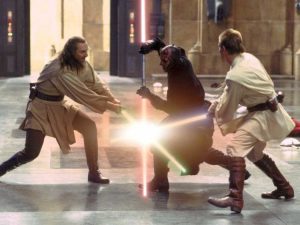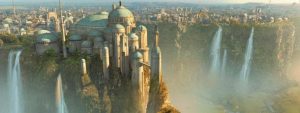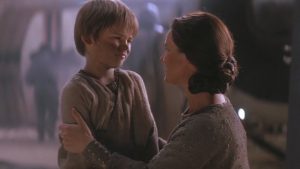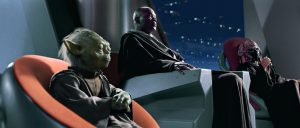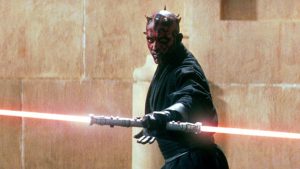We are officially in the last leg of the long journey to Star Wars: The Rise Of Skywalker, which means that the mighty Skywalker Saga, a story spanning forty years across films, books, comics, cartoons and video games is finally coming to a close – which in turn means that it’s time to reflect on that nine-part saga and take a good long look at the films that predate and inform Rise Of Skywalker‘s epic conclusion.
To do that, we’re going to have to discuss spoilers for each of the eight films in the Saga, so…SPOILERS AHEAD.
Star Wars: Attack Of The Clones
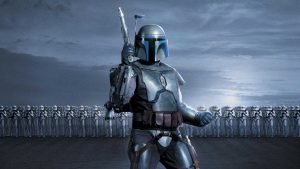
With the second movie in his hyped-up prequel trilogy, George Lucas doubled down on the much-maligned formula that made The Phantom Menace one of the Star Wars franchise’s most critically abhorred entries – leading yet another promising story to the Dark Side and leaving audiences with a bitter aftertaste of crudely overabundant CGI, meandering subplots upon subplots, emotionless acting, and what have to be some of the series’ worst-written (and consequently, most meme-able) moments. Unfortunately, while it manages to increase the stakes and introduce some fun new characters, Attack Of The Clones is largely set-up for the trilogy’s final (and best) installment.
It has to have been unintentional that the series’ protagonist Anakin Skywalker (here aged up by a couple of years and played by Hayden Christensen) is consistently the trilogy’s biggest problem. Even as the story desperately tries to probe deeper into his mind – and convince the viewer that there’s something there worth seeing – Anakin pulls away from the camera, becoming more and more distanced, as if Lucas was still too afraid to follow him on his path into darkness. Instead of being privy to this character’s decisions and consequential life-choices, we’re constantly shut out, or given the bare minimum of details that we need to understand who he is, and how he became Darth Vader (remember, that was this whole trilogy’s purpose!). For instance, Anakin has a crucial scene in this movie where, having learned that his mother Shmi (Pernilla August) was killed by Tusken Raiders, he goes about blindly massacring every Raider he can find, including women and children. Now an unrepentant butcher of innocents, a wild-eyed Anakin promptly boasts about how good it felt to slaughter them like “animals”, a horrific comment which provokes a tame response from Anakin’s girlfriend, Padmé Amidala (Natalie Portman) – “To be angry is to be human”, she says, while trying to calm him down. This entire scene does nothing to establish Anakin as a “tortured soul” of some kind: instead, it paints him as a sociopathic serial killer incapable of even grasping the concept of empathy. But there’s no lead-up to that revelation, nor is it even treated as a big deal. Within a few scenes, Anakin is back to being the film’s default hero, and we’re supposed to buy into his romance with Padmé, as if we don’t all know very well that Anakin shows signs of being or becoming the galaxy’s most abusive and nightmarish boyfriend. It’s already far too late to even try and understand what motivates Anakin’s terrifying aggression, much less rationalize whatever it might be.
And while Anakin is reduced to little more than a killing machine in this movie (and that’s just the tip of the iceberg, compared to what he does in Revenge Of The Sith), Padmé’s characterization is even worse. Natalie Portman, who would go on to win an Academy Award in 2010, is wasted in a thankless role that amounts to little more than window dressing. She stands by and supports Anakin’s violent outbursts, and can’t help falling in love with him regardless of his obvious evil. The foundation of their romance is a single conversation where Anakin infamously rants about how much he hates sand. And then, of course, there’s the tiny little detail that Anakin and Padmé have a very apparent age-gap – Anakin having been about nine when he first met the teenage princess and fell in love with her. But it’s apparently okay, because in Attack Of The Clones Anakin has aged into a full-grown man while Padmé is…still a teenager. And uh, yeah, that’s definitely how time works.
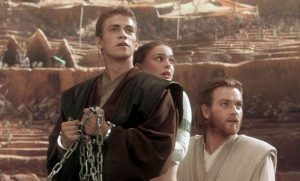
The film’s MVP is Obi-Wan Kenobi (delightfully portrayed by Ewan McGregor), who is blessed with all of Luke Skywalker’s moral purity and Han Solo’s charismatic, no-nonsense attitude. If only his subplot had anything to do with Anakin Skywalker! Then again, perhaps it’s a good thing that it doesn’t, because Obi-Wan Kenobi doing cool things by himself is far more entertaining than Obi-Wan Kenobi pretending to care about Anakin’s Jedi training. While the relationship between mentor and padawan apprentice reinforces Star Wars‘ constant theme of duality, it’s here undermined by the fact that Obi-Wan and Anakin barely ever have a relationship. Instead, Obi-Wan has a completely unrelated subplot that manages to tie back into Anakin’s story at the end of the movie because Anakin has to go rescue him, which…well, no, actually, it’s just there for cool action scenes. It does nothing to advance the plot, honestly.
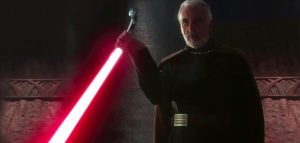
The subplot of which I speak is, of course, the Clone Wars: a very interesting story, told in a very boring way. Just as before, George Lucas’ vivid imagination bogs down the story, as he tries to cram in more unnecessary information and backstory about the histories of the Droid Separatist Armies and the clone army commissioned by Jedi Master Sifo-Dyas. It’s a shame, because the war itself is a very clever idea, and it gives the Jedi Order something to do as they become the commanders of the clone army – united, with all their lightsabers aglow and Yoda (voiced by Frank Oz) and Mace Windu (Samuel L. Jackson) leading them into battle, the Order finally looks like a formidable fighting force. And it’s a good thing too, because they’re up against the menacing Christopher Lee as Count Dooku a.k.a Darth Tyrannus, a charmingly classic addition to Star Wars canon, and another wonderful villain. The film doesn’t introduce him until relatively late in the game, and his backstory is largely left to the audience to piece together, but he doesn’t really need to be anything but Christopher Lee, dressed in aristocratic finery and expertly wielding two curved-bladed lightsabers, gently mocking his opponents’ inferior fighting skills. His battle with Yoda, in which the two masters go head-to-head, using every last trick from the Jedi rulebook, is not only one of the film’s highlights but one of the best reasons to watch the prequels at all – that and another Yoda battle in the next movie. Shamefully, however, there’s a large part of the movie that does nothing with either Yoda or Count Dooku, and instead tries to sell the idea that Boba Fett’s father is an interesting character because…he’s Boba Fett’s father?
You know how I feel about Boba Fett. I’ve simply never cared about him one way or the other. But now, I’m expected to care that his father, Jango Fett (Temuera Morrison), was the model for Sifo-Dyas’ clone army because of a familial connection that means nothing to the story. Jango could have been literally anyone else, and it would not have mattered. All that Boba does in the movie is watch as Mace Windu decapitates his father – as if there’s some sort of revenge arc to be set up, even though nothing of the kind ever occurs, either in the prequels or in the original trilogy, where Boba meets an untimely fate even more ridiculous than that of his dad. And worse, the whole situation is exemplary of everything that so often goes wrong with prequels in general: it makes the Star Wars universe smaller, by implying that the only people worth following are the characters we all know from the first trilogy, or their parents and extended family. Luckily, all these characters just so happen to be in the same place at the same time! Boba Fett (Daniel Logan) is there, as a moody little kid; Owen Lars (Joel Edgerton) is there; R2-D2 (Kenny Baker) is there; C-3PO (Anthony Daniels) is there because he was apparently built by Anakin Skywalker, a retcon that serves no purpose, as Anakin and C-3PO share only a handful of scenes, and Darth Vader never even acknowledges the droid; Mon Mothma (Genevieve O’Reilly) is in there too, somewhere; the Death Star is there because why not at this point. The Death Star gets shoved into so many Star Wars movies, it barely even registers anymore.

Just as obnoxious as the fan-service is George Lucas’ usage of CGI technology. I will never understand how a movie like Attack Of The Clones could have come out the same year as The Two Towers, which was a brilliant display of everything that special effects can achieve when applied to film. Clones‘ CGI has aged spectacularly badly, from the fight-scenes on Geonosis that look like video-game cutscenes, to Jedi stunts that attempt to resemble wuxia wire-work martial arts – but without the wire-work. And then, of course, there are the clone armies…again, how could Lord Of The Rings get this technology so right, while Star Wars got it so, so wrong?
And at last we come to the film’s finale, which basically exists to tease the next movie. Droids and clones erupt onto the battlefields of Geonosis to wage warfare, the Jedi and the Sith prepare for the conflict of the century, and then…well, then comes Revenge Of The Sith, which takes place at the very end of the Clone Wars, before we’ve even had a chance to actually witness them onscreen. There’s a long-running animated TV show that covers the events between the two films, but for moviegoers, the Clone Wars themselves are barely a blip in the Star Wars timeline. The irony of the matter is that the epic ending of Clones finally indicated that Lucas’ preference for plot over character might actually pay off – but in Revenge Of The Sith, he changed course and made the movie all about Anakin, giving us little more than hints and glimpses of the warfare, political intrigue and intergalactic trade law that had been the series’ defining feature. Just as it was beginning to get good!
It’s worth noting that another high-profile prequel franchise, the Fantastic Beasts series, has similarly promised us a war of wizards and dark magic, and it’s to be hoped that they take a hint from the failure of the Star Wars prequels, and choose to show the warfare onscreen. But that series has its own problems, anyway.
Anakin and Padmé’s ill-fated secret wedding at the end of Clones is obviously intended to be an emotional moment, the culmination of a hopelessly beautiful love story: and it probably would have been, if the couple had any chemistry. But we’re dealing with one character who’s a raging lunatic with anger-management issues and a whiny, pessimistic attitude toward literally everything, and the other who’s…um, does Padmé even have a defining character trait? She was a politician in Phantom Menace, but Clones reduces that idea to “hey, we’ll have her spurt random political metaphors at inopportune moments!”. The film also tries to hint at a concept which would become a major plot point in Revenge Of The Sith; that Anakin was jealous of Obi-Wan and Padmé’s nonexistent relationship – but seriously, why? Because Obi-Wan helped him rescue Padmé from a couple of killer centipedes? It’s just yet another abusive boyfriend trope that makes Anakin even more unlikable and unsympathetic.
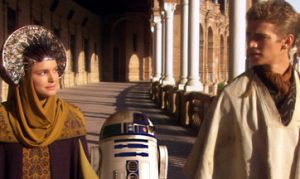
And so we are left with a film that can’t figure out the difference between a plot and a subplot; a film that tries to push a scarily nerve-wracking relationship as a cute love story; a film that wants to be thought-provoking and deep, but can’t even put together a comprehensive line of dialogue. It’s still better than the first movie for various reasons (a notable absence of Jar-Jar Binks being one of them), but not by enough to make this film a memorable – or even strictly necessary – addition to the series.
Movie Rating: 5.8/10
